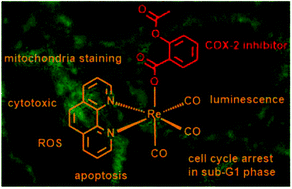当前位置:
X-MOL 学术
›
New J. Chem.
›
论文详情
Our official English website, www.x-mol.net, welcomes your feedback! (Note: you will need to create a separate account there.)
Luminescent fac-[Re(CO)3(phen)] carboxylato complexes with non-steroidal anti-inflammatory drugs: synthesis and mechanistic insights into the in vitro anticancer activity of fac-[Re(CO)3(phen)(aspirin)]†
New Journal of Chemistry ( IF 3.3 ) Pub Date : 2018-11-23 00:00:00 , DOI: 10.1039/c8nj05494k Joanna Skiba 1, 2, 3, 4, 5 , Aleksandra Kowalczyk 3, 5, 6, 7, 8 , Paweł Stączek 3, 5, 6, 7, 8 , Tytus Bernaś 5, 9, 10, 11 , Damian Trzybiński 1, 5, 12, 13, 14 , Krzysztof Woźniak 1, 5, 12, 13, 14 , Ulrich Schatzschneider 15, 16, 17, 18 , Rafał Czerwieniec 18, 19, 20, 21 , Konrad Kowalski 1, 2, 3, 4, 5
New Journal of Chemistry ( IF 3.3 ) Pub Date : 2018-11-23 00:00:00 , DOI: 10.1039/c8nj05494k Joanna Skiba 1, 2, 3, 4, 5 , Aleksandra Kowalczyk 3, 5, 6, 7, 8 , Paweł Stączek 3, 5, 6, 7, 8 , Tytus Bernaś 5, 9, 10, 11 , Damian Trzybiński 1, 5, 12, 13, 14 , Krzysztof Woźniak 1, 5, 12, 13, 14 , Ulrich Schatzschneider 15, 16, 17, 18 , Rafał Czerwieniec 18, 19, 20, 21 , Konrad Kowalski 1, 2, 3, 4, 5
Affiliation

|
Four fac-[Re(CO)3(phen)(L)] complexes with phen = 1,10-phenanthroline and L = a non-steroidal anti-inflammatory drug (NSAID) carboxylate ligand were obtained from the reaction of fac-[ReCl(CO)3(phen)] with ligands such as aspirin, (S)-(+)-ibuprofen, (S)-(+)-naproxen and indomethacin. Single-crystal X-ray diffraction analysis revealed a pseudo-octahedral coordination of the rhenium atom whereas the NSAID carboxylates act as monodentate ligands. The complexes show orange luminescence in polar solvents. Of the four compounds obtained, only fac-[Re(CO)3(phen)(aspirin)] exhibited activity against HeLa human cancer cells while it was inactive against the non-tumorigenic mouse L929 cell line. After uptake and dissociation in HeLa cells, the fac-[Re(CO)3(phen)(aspirin)] complex produces the luminescent fac-[Re(CO)3(phen)]+ cation, which predominantly accumulates in the mitochondria but does not penetrate to the nucleus, as shown by confocal microscopy. Once generated, the fac-[Re(CO)3(phen)]+ cation reversibly binds to hen egg white lysozyme (HEWL) while the aspirin ligand holds the ability to inhibit the COX-2 enzyme. The anticancer activity of the fac-[Re(CO)3(phen)(aspirin)] complex could be linked to ROS production, and cell cycle disturbance followed by triggering an apoptotic pathway of cell death.
中文翻译:

发光的fac- [Re(CO)3(phen)]羧基与非甾体类抗炎药的复合物:fac- [Re(CO)3(phen)(阿司匹林))体外抗癌活性的合成和机理研究†
四个FAC - [的Re(CO)3(phen)的(L)]与苯= 1,10-菲咯啉和L络合物=从的反应得到的非甾体抗炎药(NSAID)羧酸酯配体FAC - [ ReCl(CO)3(phen)]与阿司匹林,(S)-(+)-布洛芬,(S)-(+)-萘普生和消炎痛等配体。单晶X射线衍射分析显示the原子的拟八面体配位,而NSAID羧酸盐起单齿配体的作用。该配合物在极性溶剂中显示出橙色发光。在获得的四种化合物中,只有fac- [Re(CO)3(phen)(阿司匹林)对HeLa人类癌细胞具有活性,而对非致瘤性小鼠L929细胞系则无活性。在HeLa细胞中摄取并解离后,fac- [Re(CO)3(phen)(阿司匹林)]复合物产生发光的fac- [Re(CO)3(phen)] +阳离子,其主要堆积在线粒体中,但如共聚焦显微镜所示,它不会穿透细胞核。一旦生成,fac- [Re(CO)3(phen)] +阳离子可逆地结合于鸡蛋清溶菌酶(HEWL),而阿司匹林配体则具有抑制COX-2酶的能力。FAC的抗癌活性-[Re(CO)3(phen)(阿司匹林)]复合物可能与ROS的产生有关,并且细胞周期紊乱随后触发了细胞死亡的凋亡途径。
更新日期:2018-11-23
中文翻译:

发光的fac- [Re(CO)3(phen)]羧基与非甾体类抗炎药的复合物:fac- [Re(CO)3(phen)(阿司匹林))体外抗癌活性的合成和机理研究†
四个FAC - [的Re(CO)3(phen)的(L)]与苯= 1,10-菲咯啉和L络合物=从的反应得到的非甾体抗炎药(NSAID)羧酸酯配体FAC - [ ReCl(CO)3(phen)]与阿司匹林,(S)-(+)-布洛芬,(S)-(+)-萘普生和消炎痛等配体。单晶X射线衍射分析显示the原子的拟八面体配位,而NSAID羧酸盐起单齿配体的作用。该配合物在极性溶剂中显示出橙色发光。在获得的四种化合物中,只有fac- [Re(CO)3(phen)(阿司匹林)对HeLa人类癌细胞具有活性,而对非致瘤性小鼠L929细胞系则无活性。在HeLa细胞中摄取并解离后,fac- [Re(CO)3(phen)(阿司匹林)]复合物产生发光的fac- [Re(CO)3(phen)] +阳离子,其主要堆积在线粒体中,但如共聚焦显微镜所示,它不会穿透细胞核。一旦生成,fac- [Re(CO)3(phen)] +阳离子可逆地结合于鸡蛋清溶菌酶(HEWL),而阿司匹林配体则具有抑制COX-2酶的能力。FAC的抗癌活性-[Re(CO)3(phen)(阿司匹林)]复合物可能与ROS的产生有关,并且细胞周期紊乱随后触发了细胞死亡的凋亡途径。


























 京公网安备 11010802027423号
京公网安备 11010802027423号